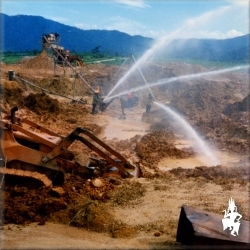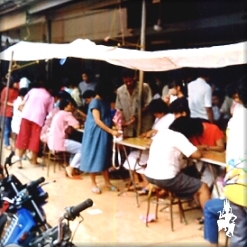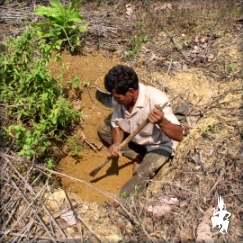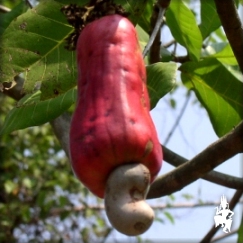Ruby Mining at Bo Rai, Trat.
|
The town of Bo Rai is situated in Trat province, about 10km from the Thai - Cambodian border and about 450km south east of Bangkok. My first visit to Bo Rai was in 1987 when the town was bustling with ruby fever. At this time most of the rubies coming onto the world markets passed through the Bo Rai’s rough ruby market in the centre of town. The market was active from 6am to 9am and most busy on Saturdays, when buyers from Bangkok & neighbouring provinces would converge on the town. |
|
|
|
The jewellery markets were hungry for rubies and the Thai stones were able to fill the demand. Burmese rubies, although considered to be the world's finest, were almost impossible to obtain. The military regime in Burma had been in control of the ruby mines for many years and the lack of investment in the industry along with restrictions on exports, meant there were virtually no rubies coming out of Burma at all. At their peak in the late 1980's, Thai rubies accounted for nearly 40% of the total exports of gems from Thailand and about 80% of the world's rubies. Bo Rai district had one of the largest ruby deposits in Thailand but was not the only place where rubies were mined in significant quantities. There were several other deposits dotted around the area in both Trat & neighbouring Chanthaburi province. |
|
Most of the mining in Bo Rai was carried out by large-scale operations using intensive opencast mining. This involved the use of high-pressure water hoses, which scared the countryside and stripped the land of its vegetation. It soon became apparent that this style of mining could not continue so in the early 90’s the Thai government imposed a total ban on mechanised mining in the area. With the ban in place and the decline in production, many of the larger mining companies crossed the border into Cambodia and set up sapphire mining operations in Pailin. This also coincided with the discovery of the huge ruby deposits at Mong Hsu and the relaxation of the restrictions on gem mining in Burma. The rubies from Mong Hsu soon took over the market from the Thai rubies, whilst blue sapphires began to flow over the border from Pailin. |
Spent bullets left over from the war in neighbouring Cambodia are commonly found in the area. |
|
The market in the centre of town, where dealers could come and rent tables by the day or month (taken in 1988). |
Dealers would sit and inspect parcels of rubies. If the stones were suitable, an offer was made (taken in 1988). |
|
There are still people digging for rubies in Bo Rai. These are mostly individuals who dig by hand on their own land, or pan in some of the rivers and streams, which snake down form the Cardamom Mountains on the Thai - Cambodian border. |
|
|
Locals in Bo Rai believe there are many rubies to be found close to the border but as mechanised mining is now banned, it would be very difficult to retrieve the stones. The border area was heavily mined (the exploding variety) during the war in Cambodia and there are still many unexploded mines littering the area. Sometimes it is possible to find rubies close to or on the ground surface, especially after rainfall. One gentleman we came across (left) who was digging a pit by hand, reached the gem bearing gravel at a depth of only two feet, after which each bucket of soil was taken away to be washed and checked for rubies. The miners are able to tell the depth of the rubies by examining the gravel as they dig. Black spinel crystals (nin or kee ploy) are commonly found at the same level as the ruby crystals and are a sign the ruby level has been reached. |
|
Rubies from Bo Rai have a high iron content and if they show any fluorescence it is very weak by comparison to the strongly fluorescent chromium rich Burmese rubies. This gives Bo Rai rubies a distinctive darker red body colour and areas of black extinction in faceted stones. The rubies do however tend to be clean and can sometimes cut very fine gems. Most rubies recovered have purple or brown overtones and require heat-treatment to improve colour. Much of the material found is formed as small tabular crystals or water worn pebbles. Today, stones over a carat are few and far between. |
|
 |
 |
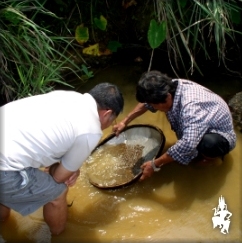 |
 |
| A river known locally as a source for rubies. The river has been worked extensively. On the banks of the river there are stacks pebbles and piles of gravel, all the leftovers from sieving. Gold is also found on occasions. | |
|
|
The area around Bo Rai is now used extensively for fruit growing. There is plenty of rainfall in Trat and the neighbouring province of Chanthaburi, making the region ideal for many different fruit types. Durians & rambutans are grown extensively in this region. The durians grown in this region are some of the tastiest in the world but an acquired taste. The region is also renowned for another delicacy - the cashew nut. These nuts grow below the fruit of the cashew trees an have a tough outer shell. The locals place the un-shelled nuts into smouldering fires to cook the nuts. Once the fire has cooled the burnt shells crumble away to reveal a tasty nut. The fruit itself is not eaten but the juice is very sweet. |









